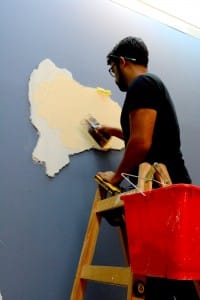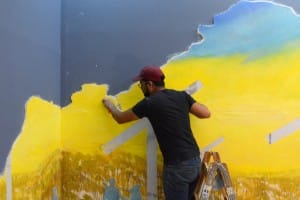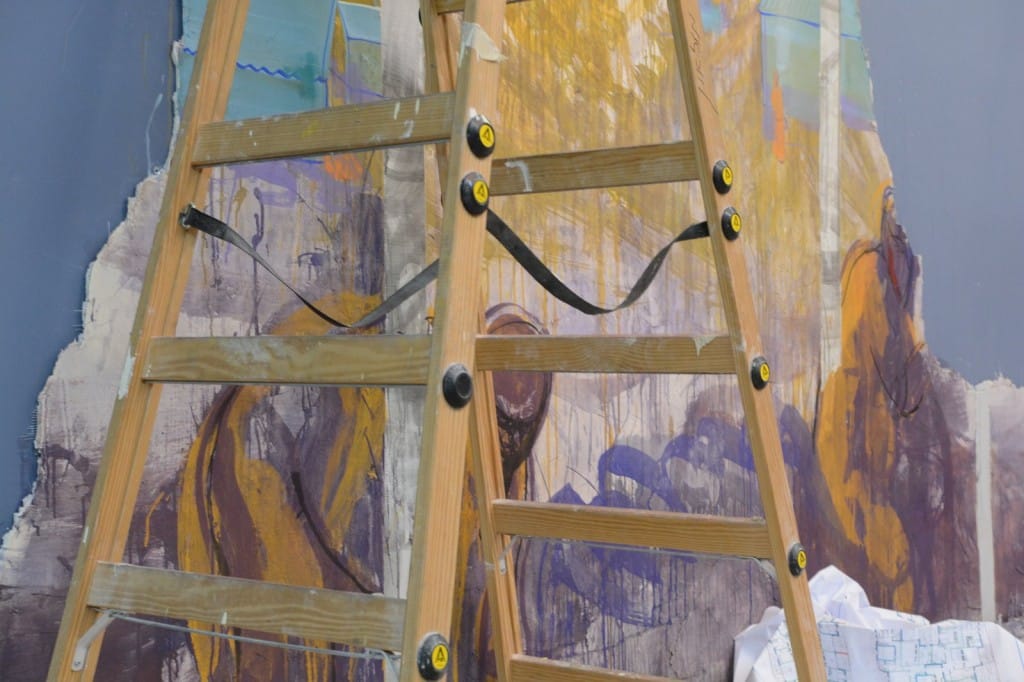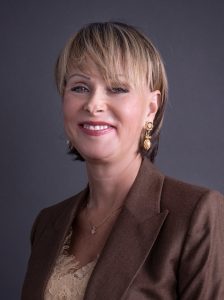“מחול השותלים” פרסקו של מידד אליהו פותח את התערוכה “מארג: זיקות למסורות באמנות המערב בציור עכשווי בישראל” שאצרתי במוזיאון פתח תקווה לאמנות. בעבודה היפיפיה הזו, המורכבת והמרגשת יש את כל נושאי העל של התערוכה: את היחס לעבר הקרוב והרחוק, השיח עם תולדות האמנות והתחושה החדה, המשוננת, של הווה.

Public Works, Jerusalem Hills
Photo :Elad Sarig
ב”מחול השותלים”, אליהו מתכתב עם היסטוריות שונות של פרסקאות: זו של הרנסנס, בעיקר האיטלקי (ג’וטו, מזאצ’ו וכמובן – מיכלאנג’לו), וזו של המאה ה-20, שבה בלטו אמני פרסקו דרום-אמריקניים (חוסה קלמנטה אורוסקו, דייגו ריוורה ודוד אלפרו סיקיירוס). אמנים אלו השתמשו בפרסקו כשופר לקידום רעיונות סוציאליסטיים. באמנות המקומית מדובר במדיום שנותר מִשני, כמעין בן חורג בקאנון הישראלי. ציורי הקיר של יוחנן סימון, של שלום סבא ושל אברהם אופק, למשל, זכו להכרה מוגבלת בלבד.

אליהו עוסק בהיסטוריה הישראלית, בכאב שהודחק ומסרב לשכוך במושבים, שאליהם הובאו עולים כמגשימי חזון ההתיישבות, אך לא זכו להכרה כחלוצים. הוא מטפל באופן ספציפי בשבר שחוותה קהילת יהודי קוצ’ין, שיושבו במושב מסילת ציון – למורת רוחם של מקימיו יוצאי תימן, שעזבוהו במחאה– באמצעות דמויות מיתיות, בעיקר של גברים חסונים

Public Works, Jerusalem Hills
Photo: Sefi Porat
הנראים כמי שהוכרעו על ידי המציאות. הדמויות הגדולות הן כעין הפכים לדמויות שבפרסקו באולם הענקים, שתכנן ג’וליו רומנו בפלאצו דל טה במנטובה (Palazzo del Té, Mantua, 1524–34), שם מתואר הרגע, שבו נענשים הענקים על ידי האלים האולימפיים שבהם ביקשו למרוד, והסצנה מלאת תכונה. בעבודתו של אליהו, הפסיביות של הדמויות מעיקה יותר מכל בוקה ומבולקה בתיאור הענקים של רומנו. העבודה כוללת גם אזכורים למאבק האנושי בשממה שנחשב למאבק של “קִדמה”, עד שהובן ההרס האקולוגי הצפוּן בו.

Public Works, Jerusalem Hills
Photo: Sefi Porat
שם העבודה לקוח משיר פרי עטו של יואל אלעזר שתיל משנת 1953, המהלל את מלאכת השתילה. לדידם של אנשי מסילת ציון, שתילה הייתה מזוהה עם עבודות הדחק, שהיו מקור התעסוקה הכמעט בלעדי האפשרי לאנשי המושב, לכל הפחות עד לשנות ה-60. בחינת העבר של מושבי העולים מקוצ’ין, לרבות המושב שבו מתגוררת משפחת האמן, מתרחשת בתוך המוזיאון ב”אם המושבות”, בלב האתוס הישראלי. בתודעה הפנימית של “מחול השותלים” מפעמת הידיעה, כי העבודה תפורק עם תום התערוכה.
https://www.youtube.com/watch?v=qUHp-nzMEro
תודעת הזמניות, וההכרה בכך שפרויקטים מאין אלו אינם שכיחים הובילה אותי לבקש מספי פורת לתעד את תהליך העבודה לכל אורכו (מעל שבועיים). התצלומים והסרטון המצוינים נעשו על ידו בהתנדבות – תודה ממידד וממני.
מארג– זיקות למסורות באמנות המערב בציור עכשווי בישראל אוצרת: ד”ר סמדר שפי
15/09/2016 – 15.12.2016
ולקבלת הודעות לגבי סיורי אמנות מיוחדים עם ד”ר סמדר שפי אנא כיתבו לכתובת thewindowartsite@gmail.com
הרשמה לניוזלטר הפירסומי השבועי של “החלון” בנושאי אמנות, אירועים ותערוכות חדשות – www.smadarsheffi.com/?p=925 (הרישום נפרד מהרישום לבלוג )
Meydad Eliyahu Public Works, Jerusalem Hills in Intricate Affinities: Recollection of Western Tradition in Local Contemporary Art
Meydad Eliyahu‘s mural Public Works, Jerusalem Hills (“Planters’ Dance” in Hebrew) portrays structures, scenery, and people which spawn a deconstructed place, like a fragmentary memory or a reality that resists coherence.

Public Works, Jerusalem Hills
Photo: Sefi Porat
In terms of medium, it is a traditional fresco: wet plaster freshly applied on the wall, on which the artist paints with color (pigment blended with water), the time at his disposal dictated by the material’s drying rate. Paint and plaster become one. Eliyahu alludes to different histories of fresco: that of the Renaissance, mainly Italian (Giotto, Masaccio, and obviously Michelangelo), and that of the 20th century, in which Latin American muralists stood out (José Clemente Orozco, Diego Rivera, and David Alfaro Siqueiros), who used fresco as a mouthpiece to promote socialist ideas. Eliyahu addresses Israeli history; the repressed pain which refuses to die in the moshavim (agricultural settlements) to which new immigrants were brought to realize the vision of settlement, yet were not recognized as pioneers. Specifically, he touches upon the rift experienced by the community of Malabar (Cochin) Jews, who were settled in Moshav Mesilat Zion—to the great dismay of its Yemenite founders, who left in protest7—by means of mythical figures, mainly those of robust men who look as though they have been vanquished by reality. The monumental figures here seem antithetical to the figures in the Chamber of Giants fresco designed by Giulio Romano in Palazzo del Té, Mantua (1524–34); a hectic scene depicting the moment in which the giants are punished by the Olympian gods following their mutiny. In Eliyahu’s work, the passivity of the figures is more disconcerting than any commotion in Romano’s portrayal of the giants. The work also refers to the human struggle with the wilderness considers as “progress,” before the ecological destruction involved was fully comprehended. The Hebrew title of the work was borrowed from a 1953 poem by Yoel Elazar Shatil exalting the act of planting. For the people of Mesilat Zion, planting was identified with the public works which were their almost exclusive source of livelihood, at least until the 1960s. This perusal of the past of the Cochin Jews’ agricultural settlements, including the moshav in which the artist’s family resides, occurs in a museum in Petach Tikva, the “Mother of Settlements,” at the very heart of the Israeli ethos.
Eliyahu addresses Israeli history; the repressed pain which refuses to die in the moshavim (agricultural settlements) to which new immigrants were brought to realize the vision of settlement, yet were not recognized as pioneers. Specifically, he touches upon the rift experienced by the community of Malabar (Cochin) Jews, who were settled in Moshav Mesilat Zion—to the great dismay of its Yemenite founders, who left in protest7—by means of mythical figures, mainly those of robust men who look as though they have been vanquished by reality. The monumental figures here seem antithetical to the figures in the Chamber of Giants fresco designed by Giulio Romano in Palazzo del Té, Mantua (1524–34); a hectic scene depicting the moment in which the giants are punished by the Olympian gods following their mutiny. In Eliyahu’s work, the passivity of the figures is more disconcerting than any commotion in Romano’s portrayal of the giants. The work also refers to the human struggle with the wilderness considers as “progress,” before the ecological destruction involved was fully comprehended. The Hebrew title of the work was borrowed from a 1953 poem by Yoel Elazar Shatil exalting the act of planting. For the people of Mesilat Zion, planting was identified with the public works which were their almost exclusive source of livelihood, at least until the 1960s. This perusal of the past of the Cochin Jews’ agricultural settlements, including the moshav in which the artist’s family resides, occurs in a museum in Petach Tikva, the “Mother of Settlements,” at the very heart of the Israeli ethos.
***
The project was documented by Sefi Porat – its exciting stages would not have been recorded without his generous contribution of talent time and good will .
Intricate Affinities: Recollections of Western Tradition in Local Contemporary Art
Curator: Smadar Sheffi
Join the mailing list for Window’s weekly informational advertising newsletter –
www.smadarsheffi.com/?p=925






